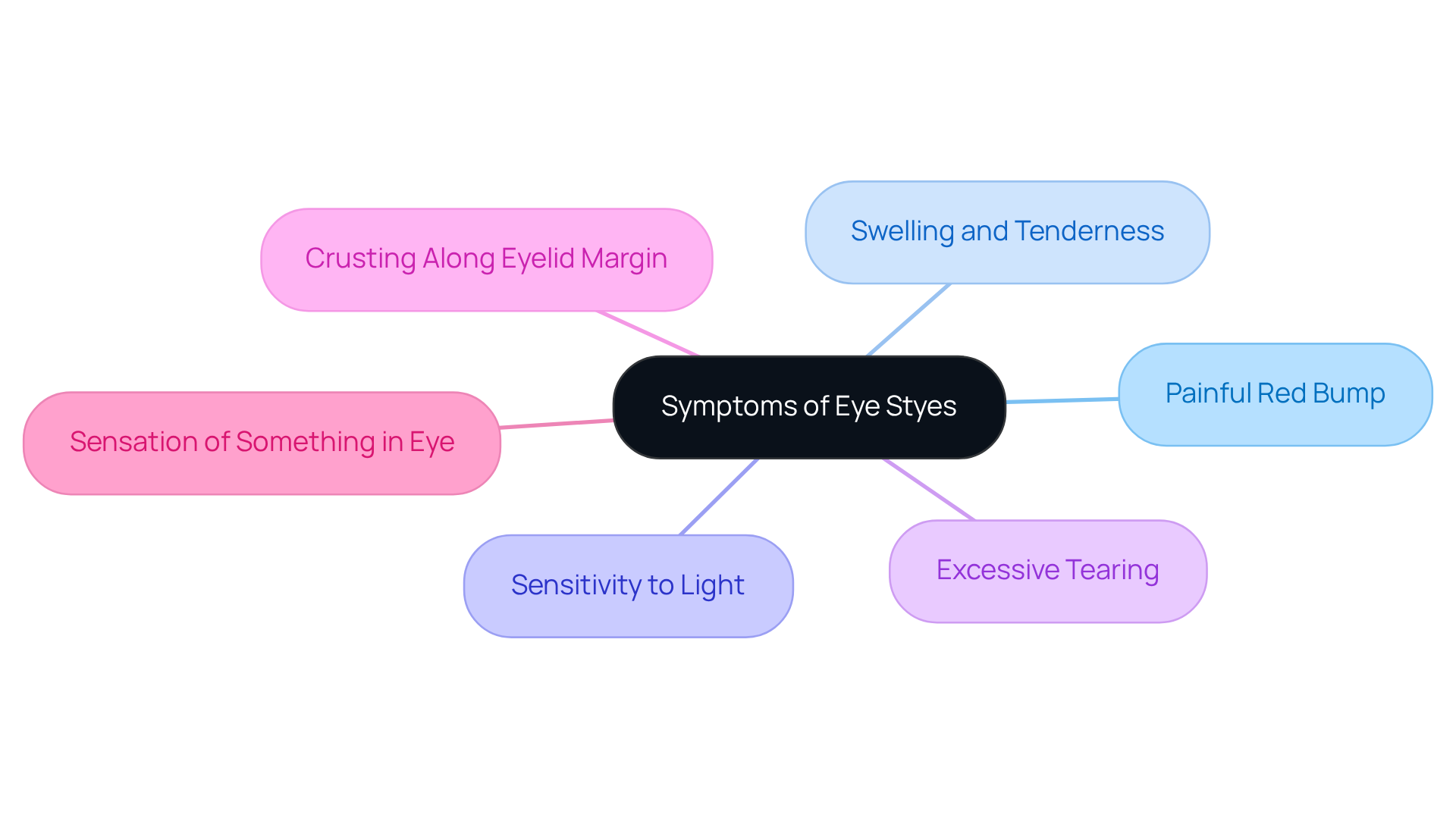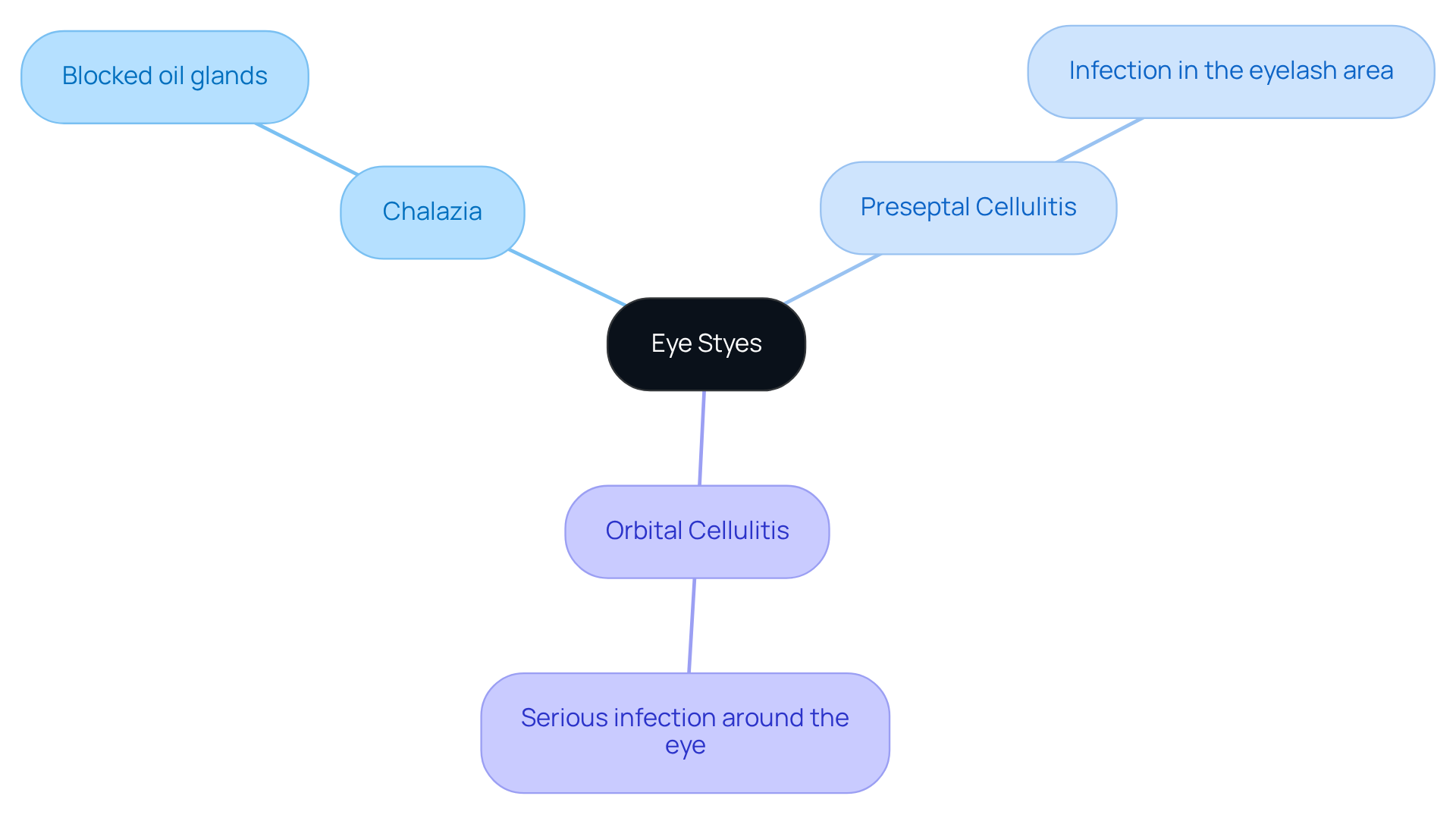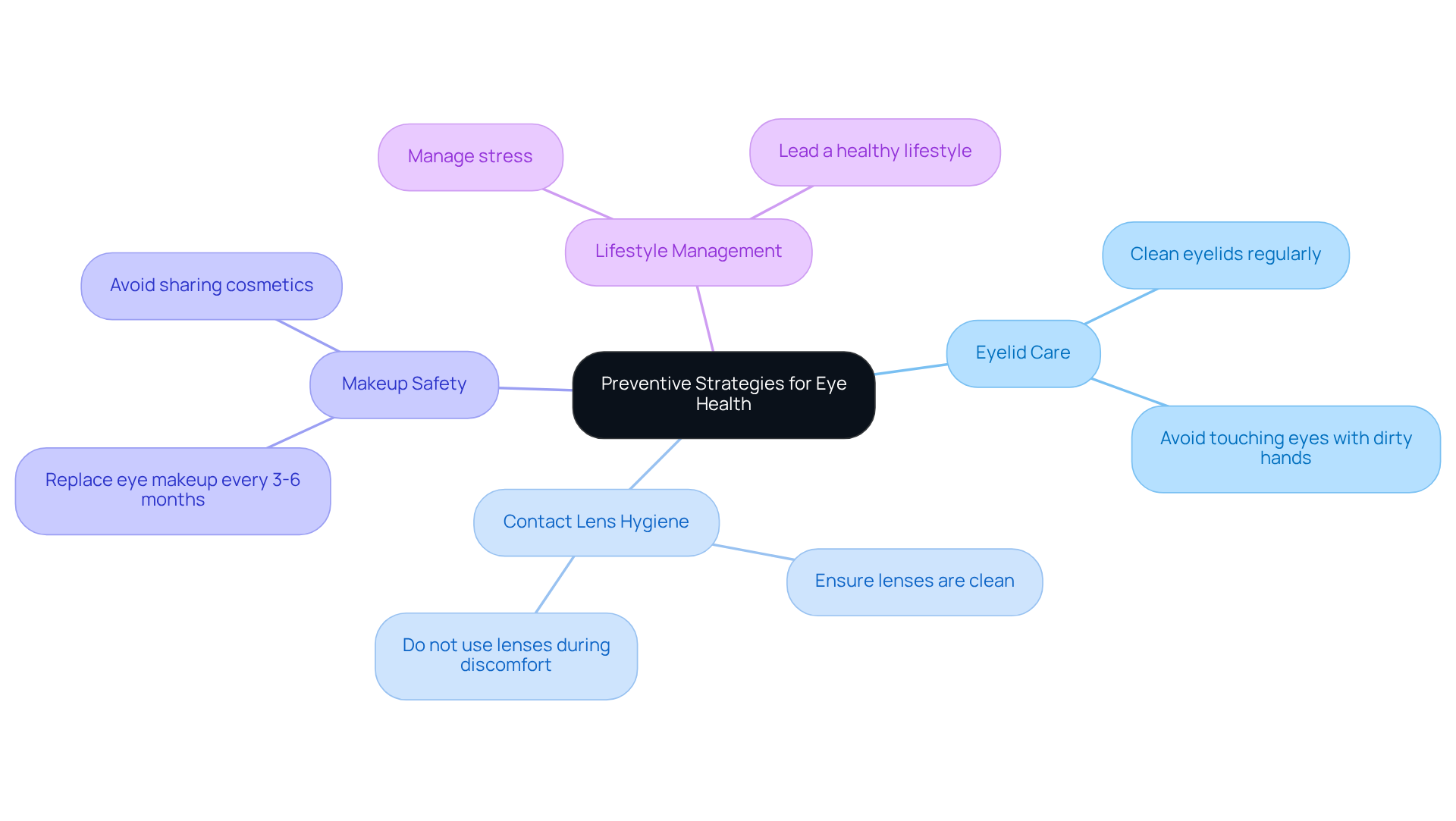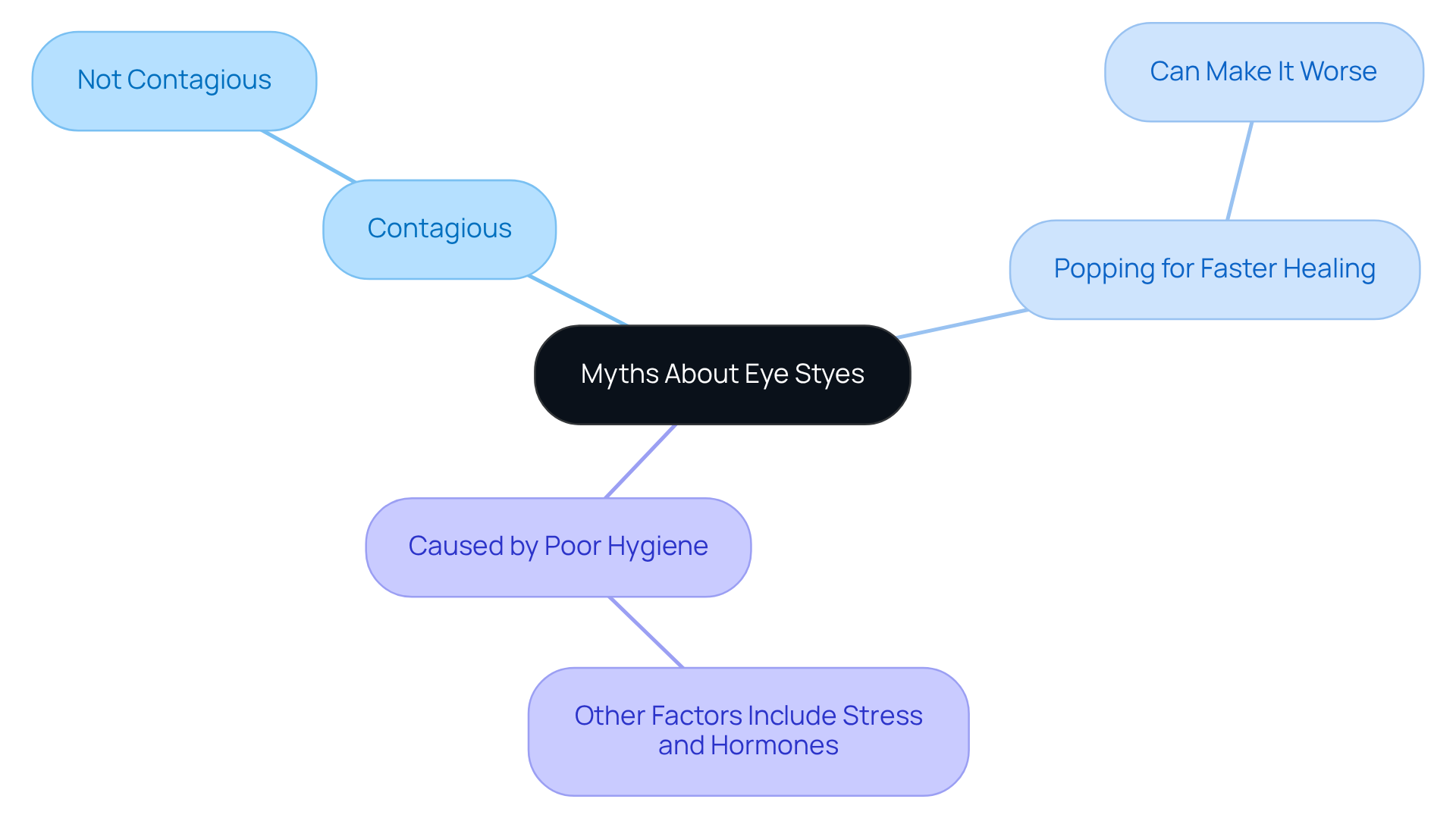Posted by: Northwest Eye in General on November 22, 2025
Introduction
Understanding the complexities of eye health is essential, especially when it comes to common yet often misunderstood conditions like eye styes. We understand that these painful bumps can disrupt your daily life. Recognizing their causes, symptoms, and treatment options can empower you to take control of your eye care.
What happens when these seemingly benign irritations go untreated? It’s common to feel confused about how to differentiate between myth and reality in the realm of eye health. This article delves into seven key insights about eye styes, offering valuable knowledge for effective management and prevention. We are here to help you through this process.
Northwest Eye: Comprehensive Treatment Options for Eye Styes
At Northwest Eye, we truly understand that dealing with eye irritations can be uncomfortable and concerning. That’s why we offer a variety of treatment options tailored to your needs, including:
- Warm compresses
- Eyelid care instructions
- Prescribed medications (if necessary)
Our dedicated team of experienced ophthalmic surgeons is here to provide you with personalized care that addresses your specific situation.
We believe in the importance of early intervention, and as part of our comprehensive eye care services, we ensure thorough follow-up care to monitor your recovery. It’s common to have questions or concerns during the healing process, and we’re here to support you every step of the way.
With multiple locations, including Minnetonka and Maple Grove, accessing specialized care has never been easier. We are here to help you through this process, ensuring you feel comfortable and informed about your treatment options.
Common Causes of Eye Styes: Understanding the Triggers
Eye bumps can be concerning, and we understand how they might affect your daily life. These bumps are often triggered by bacterial infections, particularly from Staphylococcus aureus, which can infect the oil glands around your eyes. One significant risk factor is inadequate eyelash hygiene. By gently cleansing the area with mild soap or using specialized wipes, you can help reduce your chances of developing these bumps.
Stress and hormonal changes also play a crucial role in eye health. For example, hormonal fluctuations can lead to increased oil production, which may clog glands. It’s common to feel overwhelmed by stress or sleep deprivation, and these factors can significantly impact your eyelid health. Additionally, underlying skin issues like blepharitis can worsen the likelihood of developing eye lumps.
Allergies and eye infections, such as conjunctivitis and dry eye disease, can irritate your eyes and lead to complications like chalazia. Using contaminated eye makeup or improperly sanitized contact lenses can further heighten your risk of infection. To protect yourself, consider discarding old cosmetics and avoid sharing makeup with others.
Understanding these triggers can empower you to adopt better eye care habits and lower your risk of infections. Most eyelid infections typically clear up on their own within one to two weeks, which can be reassuring for those affected. To maintain your eye health, we encourage you to schedule regular eye exams and consult a professional if symptoms persist. Remember, we are here to help you through this process.

Recognizing Symptoms of Eye Styes: Key Indicators to Watch For
We understand that noticing a painful, red bump, possibly a stye on eyeball, on your eyelash area can be concerning. This bump, which is often a stye on eyeball, typically comes with swelling and tenderness, and it’s common to experience increased sensitivity to light, excessive tearing, and crusting along the eyelid margin. Many people also report a sensation of having something in their eye, which can be quite uncomfortable, particularly if they have a stye on eyeball.
Recognizing these symptoms early is essential. It can lead to swift medical care, helping to prevent the condition from worsening. Research shows that about 1 in 5 people will experience an eye infection at some point in their lives, highlighting just how common this issue is.
Understanding these key indicators can empower you to seek the appropriate care and manage your eye health effectively. Remember, you’re not alone in this; we are here to help you through this process.

Effective Treatment Methods for Eye Styes: What You Need to Know
We understand that dealing with a stye on the eyeball can be a concerning issue. The initial approach often involves using warm compresses on the affected area several times a day. This simple step can help reduce inflammation and promote drainage of any stye on the eyeball.
Maintaining good eye hygiene is crucial during this time. We recommend gently cleaning the area around your eyes with diluted baby shampoo or commercial scrubs. It’s common to feel uncertain about the best practices, but taking these steps can make a significant difference in your recovery.
If you find that the stye on the eyeball isn’t improving, don’t worry. Your healthcare provider may prescribe antibiotic ointments or oral antibiotics to help you heal. In rare cases, surgical drainage might be necessary, but this is typically reserved for persistent or severe situations.
Remember, we are here to help you through this process. Your comfort and well-being are our top priorities.

Potential Complications of Eye Styes: Risks of Ignoring Treatment
We understand that noticing bumps around your eyes can be concerning. If left unaddressed, these bumps can lead to complications such as:
- Chalazia, which are blocked oil glands
- Preseptal cellulitis, an infection in the eyelash area
- Orbital cellulitis, a serious infection around the eye
It’s common to feel anxious about these potential issues, especially when they can result in increased pain, swelling, and even vision problems. That’s why it’s essential to seek treatment at the first sign of an eye infection. By doing so, you can help prevent these complications and ensure your well-being.
Remember, we are here to help you through this process. Seeking care early can make a significant difference in your recovery and peace of mind.

Preventive Strategies for Eye Styes: Tips for Maintaining Eye Health
We understand that taking care of your eyes is essential, and maintaining proper eyelid care is a crucial step in avoiding eye infections. It’s important to consistently clean your eyelids and refrain from touching your eyes with dirty hands. We recommend replacing your eye makeup every three to six months and avoiding sharing cosmetics to keep your eyes safe.
For those who wear contact lenses, ensuring they are clean and not using them during any discomfort can significantly reduce the risk of infections. Remember, your comfort matters, and taking these precautions can help you feel more secure.
Additionally, managing stress and leading a healthy lifestyle can greatly contribute to your overall eye health. We are here to help you through this process, and we encourage you to take these steps for your well-being.

Debunking Myths About Eye Styes: What You Should Know
We understand that dealing with eye infections can be confusing and concerning. Many myths surround these conditions, and it’s important to clarify them. For instance, a common misunderstanding is that eye bumps are contagious. In reality, they cannot be passed from one person to another, so there’s no need to worry about spreading them.
Another prevalent belief is that popping an eye infection will help it heal faster. However, this can actually make the situation worse. It’s common to feel frustrated when healing seems slow, but patience is key.
While poor hygiene is often blamed for eye infections, they can also arise from various factors, including stress and hormonal changes. Recognizing these causes can empower you to take control of your eye health.
Debunking these myths is essential for effectively managing and preventing a stye on eyeball. We are here to help you through this process, ensuring you can take informed steps toward better eye health. Remember, you’re not alone in this journey.

Conclusion
Understanding eye styes – whether it’s their causes, symptoms, or treatment options – can truly enhance your ability to manage and prevent these common eye irritations. We understand that dealing with eye styes can be frustrating, and this article aims to shed light on their multifaceted nature, emphasizing the importance of awareness and proactive care. By recognizing the triggers and symptoms early on, you can take the necessary steps to seek timely treatment and alleviate discomfort.
Key insights to keep in mind include:
- Common causes such as bacterial infections, poor eyelash hygiene, and stress.
- Symptoms like redness, swelling, and tenderness.
- Effective treatment methods, ranging from warm compresses to prescribed medications.
- Preventive strategies to maintain overall eye health.
- Debunking myths surrounding eye styes to reinforce the need for accurate information to dispel fears and misconceptions.
Ultimately, prioritizing your eye health and seeking professional care when necessary is essential for preventing complications associated with untreated styes. By adopting better hygiene practices, managing stress, and staying informed, you can empower yourself to maintain your eye health and reduce the likelihood of future occurrences. Remember, taking proactive steps today can lead to a more comfortable and healthier tomorrow. We are here to help you through this process.
Frequently Asked Questions
What treatment options are available for eye styes at Northwest Eye?
Northwest Eye offers a variety of treatment options for eye styes, including warm compresses, eyelid care instructions, and prescribed medications if necessary.
How does Northwest Eye ensure personalized care for patients with eye styes?
The dedicated team of experienced ophthalmic surgeons at Northwest Eye provides personalized care tailored to each patient’s specific situation, with a focus on early intervention and thorough follow-up care.
Where are the Northwest Eye locations situated?
Northwest Eye has multiple locations, including Minnetonka and Maple Grove, making it easier for patients to access specialized care.
What are the common causes of eye styes?
Eye styes are often triggered by bacterial infections, particularly from Staphylococcus aureus, which can infect the oil glands around the eyes. Other contributing factors include inadequate eyelash hygiene, stress, hormonal changes, underlying skin issues like blepharitis, allergies, and using contaminated eye makeup.
How can individuals reduce their chances of developing eye styes?
Individuals can reduce their chances of developing eye styes by maintaining good eyelash hygiene, gently cleansing the area with mild soap or specialized wipes, managing stress, and discarding old cosmetics.
How long does it typically take for eyelid infections to clear up?
Most eyelid infections, including eye styes, typically clear up on their own within one to two weeks.
When should someone consult a professional about their eye health?
It is advisable to consult a professional if symptoms persist or if there are concerns regarding eye health. Regular eye exams are also encouraged to maintain overall eye health.






